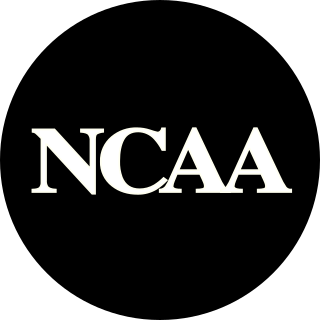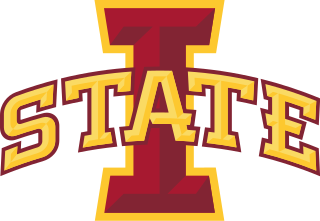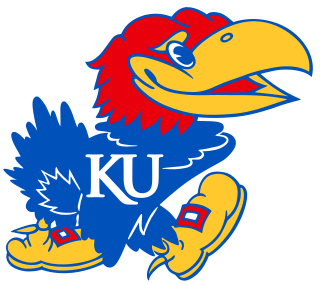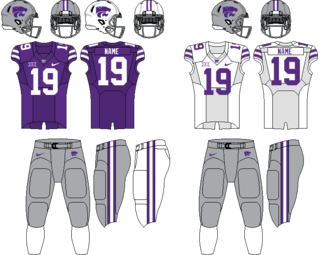Membership timeline

The Big Eight Conference is a defunct college athletic conference that was formerly affiliated with the National Collegiate Athletic Association (NCAA) Division I-A (now known as FBS).
The Big Eight Conference was a successful football conference, with its member schools being recognized as consensus national champion on eleven occasions, including the last two football seasons the conference existed (1994 and 1995). Seven players from the Big Eight won the Heisman Trophy, the most prestigious national award for college football players.

The conference was formed in 1907 as the Missouri Valley Intercollegiate Athletic Association (MVIAA) by five charter schools: the University of Kansas, University of Missouri, University of Nebraska, University of Iowa, and Washington University in St. Louis. After the MVIAA grew to ten schools, six state schools split away on their own in 1928, becoming known as the "Big Six": Iowa State, Kansas, Kansas State, Missouri, Nebraska and Oklahoma. The University of Colorado was added in 1948, and the conference became known as the "Big Seven Conference". Oklahoma State joined in 1958, becoming the eighth and final member. The conference broke up when its members joined the Big 12 Conference in 1996.
Due to its common history with the Missouri Valley Conference, Big Eight championships from 1907 through 1927 are also claimed by the MVC.
The first Big Eight conference team to attend a bowl game was Missouri, at the 1924 Los Angeles Christmas Festival. Following the 1938 season Oklahoma became the second to attend a bowl game, at the fifth-annual Orange Bowl in Miami, Florida. In 1951 and 1952 the conference had a brief ban on its members attending bowl games. When the conference resumed accepting invitations in 1953, its champion regularly thereafter attended the Orange Bowl. This tradition was broken only five times: 1964 (when Nebraska faced #2 Arkansas in the Cotton Bowl); 1966 (when Nebraska faced #3 Alabama in the Sugar Bowl); 1973 and 1974 (when undefeated Oklahoma was on probation and barred from bowl games); and 1995 (when #1 Nebraska played in the Bowl Alliance championship vs. #2 Florida at the Fiesta Bowl).
At the 1979 Orange Bowl, #6 Nebraska and #4 Oklahoma were paired against each other in a rematch of their conference game earlier in the season.
In the 1971 NCAA University Division football season, Big Eight teams finished ranked #1 (Nebraska), #2 (Oklahoma) and #3 (Colorado) in the nation in the AP Poll – the only time in college football history teams from one conference have held the top three spots in the final poll. In the final AP Poll issued before the Big Eight became the Big 12, half of the conference's teams were ranked in the nation's top 10 (#1 Nebraska, #5 Colorado, #7 Kansas State, #9 Kansas).
The Nebraska–Oklahoma football rivalry was one of the most significant in the nation, with national title implications involved during many seasons. The 1971 Nebraska vs. Oklahoma football game is commonly referred to as "The Game of the Century."
With common histories dating back even before the 1907 formation of the conference, many of the Big Eight's rivalries were among the most-played in college football. At the time the Big Eight Conference dissolved in 1996, the conference had the two longest uninterrupted series in Division I-A football: Kansas–Oklahoma (played annually since 1903) and Kansas–Nebraska (played annually since 1906). Many of the conference's series began in the 19th century, including:
All of the above series except Kansas-Iowa State have been inactive since at least 2012 due to conference realignment.
Following are the MVIAA/Big Eight football conference champions from 1907 to 1995 (shared championship years are shown in italics): [1] [2]
| Football conference championships (1907–1995) | |||
|---|---|---|---|
| School | Total titles | Outright titles | Years |
| Colorado | 5 | 3 | 1961 ·1976· 1989 · 1990 ·1991 |
| Drake | 0 | 0 | |
| Grinnell | 0 | 0 | |
| Iowa | 1 | 0 | 1907 |
| Iowa State | 2 | 0 | 1911·1912 |
| Kansas | 5 | 2 | 1908 · 1930 ·1946·1947·1968 |
| Kansas State | 1 | 1 | 1934 |
| Missouri | 12 | 10 | 1909 ·1913· 1919 · 1924 · 1925 · 1927 · 1939 · 1941 · 1942 · 1945 · 1960†·1969 |
| Nebraska | 41 | 31 | 1907· 1910 ·1911·1912·1913· 1914 · 1915 · 1916 · 1917 · 1921 · 1922 · 1923 · 1928 · 1929 · 1931 · 1932 ·1933· 1935 · 1936 · 1937 · 1940 · 1963 · 1964 · 1965 · 1966 ·1969· 1970 · 1971 · 1972‡·1975· 1978· 1981 · 1982 · 1983 ·1984· 1988 ·1991· 1992 · 1993 · 1994 · 1995 |
| Oklahoma | 34 | 26 | 1920 ·1933· 1938 · 1943 · 1944 ·1946·1947· 1948 · 1949 · 1950 · 1951 · 1952 · 1953 · 1954 · 1955 · 1956 · 1957 · 1958 · 1959 · 1962 1967 ·1968· 1972‡· 1974 ·1975·1976· 1977 ·1978· 1979 · 1980 · 1984· 1985 · 1986 · 1987 |
| Oklahoma State | 2 | 1 | 1926 ·1976 |
| Washington (St. Louis) | 0 | 0 | |
† Kansas would have won the 1960 title, but after found to be using an ineligible player they were forced to forfeit their victories over Missouri and Colorado, which meant that Missouri was awarded the 1960 Big Eight title.
‡ Oklahoma initially won the 1972 title, but after it was found that they used ineligible players, they were penalized by the NCAA, though they did not force OU to forfeit games. The Big Eight asked them to forfeit three games and awarded the title to Nebraska, but Oklahoma still claims these wins and this title.
Big Eight football teams were recognized as national champion on eleven occasions, including four times as back-to-back champions:
The Big Seven Conference established a Coach of the Year award in 1948. The conference began awarding a Player of the Year award in 1967, and began giving separate offensive and defensive awards in 1971. The final awards were given after the 1995 season, after which all of the Big Eight schools entered the Big 12 Conference.
| Season | Player | Pos. | Team |
|---|---|---|---|
| 1967 | Granville Liggins | NT | Oklahoma |
| 1968 | Steve Owens | RB | Oklahoma |
| 1969 | Steve Owens (2) | RB | Oklahoma |
| 1970 | Jerry Murtaugh | LB | Nebraska |
| 1971 | Greg Pruitt | RB | Oklahoma |
| Season | Player | Pos. | Team |
|---|---|---|---|
| 1972 | George Amundson | QB | Iowa State |
| 1973 | Joe Washington | RB | Oklahoma |
| 1975 | Joe Washington (2) | RB | Oklahoma |
| 1975 | Nolan Cromwell | QB | Kansas |
| 1976 | Terry Miller | RB | Oklahoma State |
| 1977 | Terry Miller (2) | RB | Oklahoma State |
| 1978 | Billy Sims | RB | Oklahoma |
| 1979 | Billy Sims (2) | RB | Oklahoma |
| 1980 | Phil Bradley | QB | Missouri |
| 1981 | Dave Rimington | C | Nebraska |
| 1982 | Mike Rozier | RB | Nebraska |
| 1983 | Mike Rozier (2) | RB | Nebraska |
| 1984 | Danny Bradley | QB | Oklahoma |
| 1985 | Thurman Thomas | RB | Oklahoma State |
| 1986 | Jamelle Holieway | QB | Oklahoma |
| 1987 | Thurman Thomas (2) | RB | Oklahoma State |
| 1988 | Barry Sanders | RB | Oklahoma State |
| 1989 | Darian Hagan | QB | Colorado |
| Gerry Gdowski | QB | Nebraska | |
| 1990 | Eric Bieniemy | RB | Colorado |
| 1991 | Tony Sands | RB | Kansas |
| 1992 | Calvin Jones | RB | Nebraska |
| 1993 | Charles Johnson | WR | Colorado |
| 1994 | Rashaan Salaam | RB | Colorado |
| 1995 | Tommie Frazier | QB | Nebraska |
| Season | Player | Pos. | Team |
|---|---|---|---|
| 1972 | Rich Glover | DT | Nebraska |
| 1973 | Lucious Selmon | NT | Oklahoma |
| 1974 | Rod Shoate | LB | Oklahoma |
| 1975 | Lee Roy Selmon | DT | Oklahoma |
| 1976 | Clete Pillen | DE | Nebraska |
| 1977 | George Cumby | LB | Oklahoma |
| 1978 | John Corker | LB | Oklahoma State |
| 1979 | George Cumby (2) | LB | Oklahoma |
| 1980 | Derrie Nelson | DE | Nebraska |
| 1981 | Jeff Gaylord | LB | Missouri |
| 1982 | Rick Bryan | DE | Oklahoma |
| 1983 | Rick Bryan (2) | DE | Oklahoma |
| 1984 | Leslie O'Neal | DT | Oklahoma State |
| 1985 | Brian Bosworth | LB | Oklahoma |
| 1986 | Brian Bosworth (2) | LB | Oklahoma |
| 1987 | Dante Jones | LB | Oklahoma |
| 1988 | Broderick Thomas | LB | Nebraska |
| 1989 | Alfred Williams | LB | Colorado |
| 1990 | Alfred Williams (2) | LB | Colorado |
| 1991 | Joe Bowden | LB | Oklahoma |
| 1992 | Deon Figures | CB | Colorado |
| 1993 | Trev Alberts | LB | Nebraska |
| 1994 | Ed Stewart | LB | Nebraska |
| 1995 | Tim Colston | DT | Kansas State |
| Season | Coach | Team |
|---|---|---|
| 1948 | Bud Wilkinson | Oklahoma |
| 1949 | Bud Wilkinson (2) | Oklahoma |
| 1950 | Bud Wilkinson (3) | Oklahoma |
| 1951 | Bud Wilkinson (4) | Oklahoma |
| 1952 | Bud Wilkinson (5) | Oklahoma |
| 1953 | Bud Wilkinson (6) | Oklahoma |
| 1954 | Bud Wilkinson (7) | Oklahoma |
| 1955 | Bud Wilkinson (8) | Oklahoma |
| 1956 | Dallas Ward | Colorado |
| 1957 | Chuck Mather | Kansas |
| 1958 | Dan Devine | Missouri |
| 1959 | Clay Stapleton | Iowa State |
| 1960 | Dan Devine (2) | Missouri |
| 1961 | Sonny Grandelius | Colorado |
| 1962 | Bob Devaney | Nebraska |
| 1963 | Bob Devaney (2) | Nebraska |
| 1964 | Bob Devaney (3) | Nebraska |
| 1965 | Eddie Crowder | Colorado |
| 1966 | Jim Mackenzie [3] | Oklahoma |
| 1967 | Chuck Fairbanks | Oklahoma |
| 1968 | Pepper Rodgers | Kansas |
| Dan Devine (3) | Missouri | |
| 1969 | Floyd Gass | Oklahoma State |
| 1970 | Bob Devaney (4) | Nebraska |
| 1971 | Johnny Majors [4] | Iowa State |
| 1972 | Al Onofrio [5] | Missouri |
| 1973 | Tom Osborne | Nebraska |
| Barry Switzer | Oklahoma | |
| 1974 | Barry Switzer (2) | Oklahoma |
| 1975 | Bud Moore | Kansas |
| Tom Osborne (2) | Nebraska | |
| 1976 | Earle Bruce [6] | Iowa State |
| 1977 | Earle Bruce (2) [6] | Iowa State |
| 1978 | Tom Osborne (3) | Nebraska |
| 1979 | Jimmy Johnson | Oklahoma State |
| 1980 | Tom Osborne (4) | Nebraska |
| 1981 | Don Fambrough | Kansas |
| 1982 | Jim Dickey | Kansas State |
| 1983 | Warren Powers | Missouri |
| Tom Osborne (5) | Nebraska | |
| 1984 | Mike Gottfried | Kansas |
| 1985 | Bill McCartney | Colorado |
| 1986 | Barry Switzer (3) | Oklahoma |
| 1987 | Barry Switzer (4) | Oklahoma |
| 1988 | Tom Osborne (6) | Nebraska |
| 1989 | Bill McCartney (2) | Colorado |
| 1990 | Bill Snyder | Kansas State |
| Bill McCartney (3) | Colorado | |
| 1991 | Bill Snyder (2) | Kansas State |
| Glen Mason | Kansas | |
| 1992 | Tom Osborne (7) | Nebraska |
| 1993 | Bill Snyder (3) [7] | Kansas State |
| Tom Osborne (8) | Nebraska | |
| 1994 | Tom Osborne (9) | Nebraska |
| 1995 | Glen Mason (2) | Kansas |
After the final Big Eight season was completed in 1995, a panel of twelve longtime observers selected an all-time conference team: [8]
| Position | Player | Team | Tenure |
|---|---|---|---|
| Offense | |||
| QB | Lynn Dickey | Kansas State | 1968–1970 |
| RB | Billy Sims | Oklahoma | 1975–1979 |
| Gale Sayers | Kansas | 1962–1964 | |
| WR | Hart Lee Dykes | Oklahoma State | 1985–1988 |
| Johnny Rodgers | Nebraska | 1970–1972 | |
| TE | Keith Jackson | Oklahoma | 1984–1987 |
| OL | Dean Steinkuhler | Nebraska | 1979–1983 |
| Zach Wiegert | Nebraska | 1991–1994 | |
| Greg Roberts | Oklahoma | 1975–1978 | |
| Joe Romig | Colorado | 1959–1961 | |
| C | Dave Rimington | Nebraska | 1979–1982 |
| Defense | |||
| DL | Lee Roy Selmon | Oklahoma | 1972–1975 |
| Rich Glover | Nebraska | 1970–1972 | |
| Leslie O'Neal | Oklahoma State | 1982–1985 | |
| Willie Harper | Nebraska | 1970–1972 | |
| LB | Brian Bosworth | Oklahoma | 1983–1986 |
| Gary Spani | Kansas State | 1974–1977 | |
| Rod Shoate | Oklahoma | 1972–1974 | |
| CB | Johnny Roland | Missouri | 1962–1965 |
| Roger Wehrli | Missouri | 1966–1968 | |
| S | Randy Hughes | Oklahoma | 1971–1974 |
| Rickey Dixon | Oklahoma | 1984–1987 | |
| Special Teams | |||
| K | Uwe von Schamann | Oklahoma | 1975–1978 |
| P | Barry Helton | Colorado | 1984–1987 |
| RS | Barry Sanders | Oklahoma State | 1986–1988 |
Seven players from the Big Eight won the Heisman Trophy, the most prestigious national award for college football players:
| Season | Player | Pos. | Team |
|---|---|---|---|
| 1952 | Billy Vessels | HB | Oklahoma |
| 1969 | Steve Owens | RB | Oklahoma |
| 1972 | Johnny Rodgers | WR | Nebraska |
| 1978 | Billy Sims | RB | Oklahoma |
| 1983 | Mike Rozier | RB | Nebraska |
| 1988 | Barry Sanders | RB | Oklahoma State |
| 1994 | Rashaan Salaam | RB | Colorado |
| Season | Coach | Team |
|---|---|---|
| 1949 | Bud Wilkinson | Oklahoma |
| 1989 | Bill McCartney | Colorado |
| 1994 | Tom Osborne | Nebraska |
| Season | Coach | Team |
|---|---|---|
| 1971 | Bob Devaney | Nebraska |
| 1989 | Bill McCartney | Colorado |

The Big Eight Conference was a National Collegiate Athletic Association (NCAA)-affiliated Division I-A college athletic association that sponsored football. It was formed in January 1907 as the Missouri Valley Intercollegiate Athletic Association (MVIAA) by its charter member schools: the University of Kansas, University of Missouri, University of Nebraska, and Washington University in St. Louis. Additionally, the University of Iowa was an original member of the MVIAA, while maintaining joint membership in the Western Conference.
The NCAA was without a playoff for the major college football teams in the University Division, later known as Division I-A, during the 20th century. The NCAA recognizes Division I-A national champions based on the final results of polls including the "wire service", FWAA and NFF. The 1964 AP poll continued to rank only ten teams, compiling the votes of 55 sportswriters, each of whom would give their opinion of the ten best. Under a point system of 10 points for first place, 9 for second, etc., the "overall" ranking was determined.

The Nebraska Cornhuskers football team competes as part of the NCAA Division I Football Bowl Subdivision, representing the University of Nebraska–Lincoln in the Big Ten Conference. Nebraska has played its home games at Memorial Stadium since 1923 and sold out every game at the venue since 1962.

The 1994 NCAA Division I-A football season, play of college football in the United States at the NCAA Division I-A level, began in August 1994 and ended on January 2, 1995. Nebraska, who finished the season undefeated, ended the year ranked No. 1 in both the Associated Press and Coaches polls. This was the first national championship of coach Tom Osborne's career at Nebraska, having come close the year before, when Nebraska lost to eventual national champion Florida State on a missed field goal as time expired.

The 1997 NCAA Division I-A football season, play of college football in the United States organized by the National Collegiate Athletic Association at the Division I-A level, began in late summer 1997 and culminated with the major bowl games in early January 1998. The national championship was split for the third time in the 1990s. The Michigan Wolverines finished the season atop the AP Poll after completing a 12–0 campaign with a Big Ten Conference championship and a victory in the Rose Bowl over Washington State, and the Nebraska Cornhuskers garnered the top ranking in the Coaches' Poll with a 13–0 record, a Big 12 Conference championship, and a win over Tennessee in the Orange Bowl.

The 2000 NCAA Division I-A football season ended with the Oklahoma Sooners beating the defending national champion Florida State Seminoles to claim the Sooners' seventh national championship and their thirty-seventh conference championship, the first of each since the 1988 departure of head coach Barry Switzer.

The 2001 NCAA Division I-A football season was the first college football season of the 21st century. It ended with the University of Miami winning the national title for the fifth time.

The 1983 NCAA Division I-A football season ended with the University of Miami, led by Bernie Kosar, winning their first national championship over perennial power and top ranked Nebraska in the Orange Bowl.

The Iowa State Cyclones football program is the intercollegiate football team at Iowa State University in Ames, Iowa. The team is coached by Matt Campbell. The Cyclones compete in the Big 12 Conference, and are a Division I Football Bowl Subdivision (FBS) member of the NCAA. The Cyclones play their home games at Jack Trice Stadium, with a capacity of 61,500. The Iowa State Cyclones football team drew an average home attendance of 60,384 in 2023, the 28th highest in college football.

The Kansas Jayhawks football program is the intercollegiate football program of the University of Kansas. The program is classified in the National Collegiate Athletic Association (NCAA) Division I Bowl Subdivision (FBS), and the team competes in the Big 12 Conference. The Jayhawks are led by head coach Lance Leipold.
The 1960 college football season was the 92nd season of intercollegiate football in the United States. Five teams have a claim to the 1960 major college national championship:

The 1971 NCAA University Division football season saw Coach Bob Devaney's Nebraska Cornhuskers repeat as national champions. Ranked a close second behind Notre Dame in the preseason poll, Nebraska moved up to first place the following week, remained there for the rest of 1971, and convincingly won the Orange Bowl 38–6 in a No. 1 vs. No. 2 game against Alabama.

The 1972 NCAA University Division football season saw the USC Trojans, coached by John McKay, go undefeated and win the national championship as the unanimous choice of the 50 AP panelists. Eighth-ranked in the preseason, the Trojans were narrowly voted No. 1 in the first AP poll, and stayed out front for the rest of the year.

The 1975 NCAA Division I football season saw University of Oklahoma repeat as national champion in the Associated Press (AP) writers' poll, and were ranked No. 1 in the United Press International (UPI) coaches' poll, just ahead of Arizona State, runner-up in both AP and Coaches final polls. ASU finished as the only undefeated team of the season with their victory over Nebraska in the Fiesta Bowl. Arizona State was recognized by Sporting News and National Championship Foundation as the No. 1 ranked team of the nation. Both major selection polls at the time.
The NCAA Division I Football Bowl Subdivision (FBS), formerly known as Division I-A, is the highest level of college football in the United States. The FBS consists of the largest schools in the National Collegiate Athletic Association (NCAA). As of the 2024 season, there are 10 conferences and 134 schools in FBS.

The Kansas State Wildcats football program is the intercollegiate football program of the Kansas State University Wildcats. The program is classified in the NCAA Division I Bowl Subdivision (FBS), and the team competes in the Big 12 Conference.
The 1993 All-Big Eight Conference football team consists of American football players chosen by various organizations for All-Big Eight Conference teams for the 1993 NCAA Division I-A football season. The selectors for the 1993 season included the Associated Press (AP) and Coaches poll.
The 1995 All-Big Eight Conference football team consists of American football players chosen by various organizations for All-Big Eight Conference teams for the 1995 NCAA Division I-A football season. The selectors for the 1995 season included the Associated Press (AP) and the Big Eight Conference coaches (Coaches). The 1995 team was the final All-Big Eight football team due to the conference's merger in 1996 with four teams from the Southwest Conference to form the Big 12 Conference.
The 1960 Kansas Jayhawks football team represented the University of Kansas during the 1960 college football season. The Jayhawks were led by third-year head coach Jack Mitchell and played their home games at Memorial Stadium in Lawrence, Kansas.